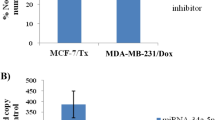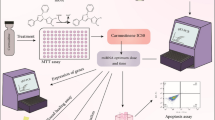Abstract
Background/Aims
The purpose of this study is to explore the inhibition or activation effects of microRNA-146 B on the expression of PTP1B in gastric cancer cells.
Methods
The expressions of PTP1B and miR-146b in gastric cancer were detected by RT-qPCR. The effects of miR-146b on cell apoptosis and proliferation of gastric cancer were detected. The methods used in the detection process included Annexin V/PI dying method, colony formation assay, and MTT assay. The downstream target gene miR-146b was predicted and screened by bioinformatics and luciferase reporter assay. The mRNA and protein expressions of the target gene PTP1B miR-146b were determined using RT-qPCR and western blot. The expression of miR-146 B in mice was detected by the cells transfected with microRNA-146 B in vivo.
Results
Compared with normal tissues, PTP1B was higher and miR-146b was lower in cancer cells. Over-expression of miR-146b can inhibit cell viability and increase the apoptosis rate. According to the luciferase reporter assay, PTP1B was the downstream target gene of miR-146b. The re-introduction of PTP1B reversed the growth inhibition and apoptosis of gastric cancer cells induced by miR-146b. From the mouse xenograft model, the over-expression of miR-146b inhibited the tumor growth and reduced the expression level of PTP1B.
Conclusion
miR-146b directly inhibits the expression of PTP1B and suppressed the growth and development of gastric cancer.




Similar content being viewed by others
References
Backert S, Ziska E, Brinkmann V, et al. Translocation of the Helicobacter pylori CagA protein in gastric epithelial cells by a type IV secretion apparatus. Cellular Microbiol. 2010;2:155–164.
Bourdeau A, Dubé N, Tremblay ML. Cytoplasmic protein tyrosine phosphatases, regulation and function: the roles of PTP1B and TC-PTP. Curr Opin Cell Biol. 2005;17:203–209.
Chen S, Li T, Zhao Q, Xiao B, Guo J. Using circular RNA hsa_circ_0000190 as a new biomarker in the diagnosis of gastric cancer. Clin Chim Acta. 2017;466:167–171.
Crabtree JE, Xiang Z, Lindley IJ, Tompkins DS, Rappuoli R, Covacci A. Induction of interleukin-8 secretion from gastric epithelial cells by a cagA negative isogenic mutant of Helicobacter pylori. J Clin Pathol. 1995;48:967–969.
Fujii H, Chiou TJ, Lin SI, Aung K, Zhu JK. A PTP1B involved in phosphate-starvation response in Arabidopsis. Curr Biol. 2005;15:2038–2043.
Grant Stemmermann M, Heffelfinger P, Sue C, et al. The molecular biology of esophageal and gastric cancer and their precursors: oncogenes, tumor suppressor genes, and growth factors. Hum Pathol. 1994;25:968.
Hashimoto Y, Akiyama Y, Yuasa Y. Multiple-to-multiple relationships between microRNAs and target genes in gastric cancer. PLoS ONE. 2013;8:e62589.
Hu XT, He C. Recent progress in the study of methylated tumor suppressor genes in gastric cancer. Chin J Cancer. 2013;32:31–41.
Hua Z, Lv Q, Ye W, et al. PTP1B-directed regulation of VEGF and other angiogenic factors under hypoxia. PLoS ONE. 2006;1:e116.
Keates S, Keates AC, Warny M, Peek RM, Murray PG, Kelly CP. Differential activation of mitogen-activated protein kinases in AGS gastric epithelial cells by cag + and cag − helicobacter pylori. J Immunol. 1999;163:5552–5559.
Kim N, Park RY, Cho SI, et al. Helicobacter pylori infection and development of gastric cancer in Korea: long-term follow-up. J Clin Gastroenterol. 2008;42:448.
Kogo R, Mimori K, Tanaka F, Komune S, Mori M. Clinical significance of miR-146a in gastric cancer cases. Clin Cancer Res. 2011;17:4277–4284.
Lu M, Song Y, Fu W, et al. MicroRNA and target mRNA selection through invasion and cytotoxicity cell modeling and bioinformatics approaches in esophageal squamous cell carcinoma. Oncol Rep. 2017;38:1181–1189.
Na W, Junjun S, Wei L, et al. Frequent amplification of PTP1B is associated with poor survival of gastric cancer patients. Cell Cycle. 2015;14:732–743.
Niwa T, Tsukamoto T, Toyoda T, et al. Inflammatory processes triggered by helicobacter pylori infection cause aberrant DNA methylation in gastric epithelial cells. Can Res. 2010;70:1430–1440.
Qiang R, Fang ZY, Cui SZ, et al. Thermo-chemotherapy induced miR-218 upregulation inhibits the invasion of gastric cancer via targeting Gli2 and E-cadherin. Tumor Biology. 2015;36:5807–5814.
Shin VY, Chu KM. PTP1B as potential biomarkers and therapeutic targets for gastric cancer. World J Gastroenterol. 2014;20:10432–10439.
Song M, Pan K, Su H, et al. Identification of serum MicroRNAs as novel non-invasive biomarkers for early detection of gastric cancer. PLoS ONE. 2013;7:e33608.
Strand MS, Lockhart AC, Fields RC. Genetics of gastric cancer. Surg Clin North Am. 2017;97:345–370.
Sun F, Yu M, Yu J, et al. miR-338-3p functions as a tumor suppressor in gastric cancer by targeting PTP1B. Cell Death Dis. 2018;9:522.
Suzuki H, Oda I, Abe S, et al. High rate of 5-year survival among patients with early gastric cancer undergoing curative endoscopic submucosal dissection. Gastric Cancer. 2016;19:198–205.
Wagner ADA, Grothe WW, Behl S, et al. Chemotherapy for advanced gastric cancer. Dig Surg. 2010;11:118–120.
Wang J, Chen X, Liu B, Zhu Z. Suppression of PTP1B in gastric cancer cells in vitro induces a change in the genome-wide expression profile and inhibits gastric cancer cell growth. Cell Biol Int. 2013;34:747–753.
Wang W, Du M, Li Z, et al. A genetic variant located in miR-146b promoter region is associated with prognosis of gastric cancer. Cancer Epidemiol Biomarkers Prev. 2018;27:822–828.
Wiener JA, Hurteau JA, Kerns BJ, et al. Over-expression of the tyrosine phosphatase PTP1B is associated with human ovarian carcinomas. Am J Obstet Gynecol. 1994;170:1177–1183.
Wu H, Cai Z, Lu G, et al. Impact of c-erbB-2 protein on 5-year survival rate of gastric cancer patients after surgery: a cohort study and meta-analysis. Tumori. 2015;103:249–254.
Yong SL, Dutta A. The tumor suppressor microRNA let-7 represses the HMGA2 oncogene. Genes Dev. 2007;21:1025–1030.
Young-Kook K, Yu J, Han TS, et al. Functional links between clustered microRNAs: suppression of cell-cycle inhibitors by microRNA clusters in gastric cancer. Nucleic Acids Res. 2009;37:1672–1681.
Yousef M, Showe L, Showe M. A study of microRNAs in silico and in vivo: bioinformatics approaches to microRNA discovery and target identification. FEBS J. 2010;276:2150–2156.
Funding
Project supported by Youth Talents Project of Science and Technology Research Program, Ministry of Education of Hubei Province, No. Q20142601.
Author information
Authors and Affiliations
Corresponding author
Ethics declarations
Conflict of interest
The authors declare that they have no conflict of interest.
Additional information
Publisher's Note
Springer Nature remains neutral with regard to jurisdictional claims in published maps and institutional affiliations.
Rights and permissions
About this article
Cite this article
Xu, J., Zhang, Z., Chen, Q. et al. miR-146b Regulates Cell Proliferation and Apoptosis in Gastric Cancer by Targeting PTP1B. Dig Dis Sci 65, 457–463 (2020). https://doi.org/10.1007/s10620-019-05771-8
Received:
Accepted:
Published:
Issue Date:
DOI: https://doi.org/10.1007/s10620-019-05771-8




